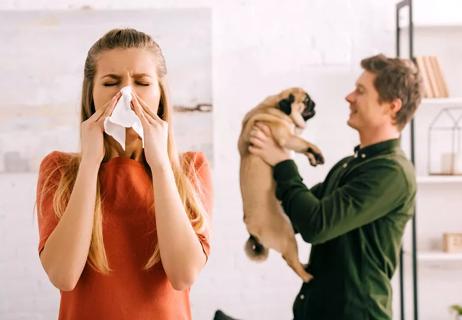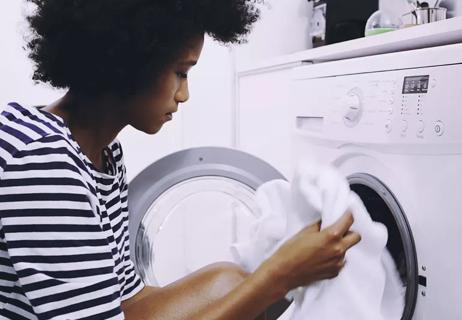Vacuum (a lot), wipe pets down (often) and (always) keep them out of your bed!

While picking a new pet can be an exciting part of life, sometimes, you come into a situation where a pet is already present. Perhaps a change in your living situation or relationship status means you’re now in contact with a pet on a regular basis.
Advertisement
Cleveland Clinic is a non-profit academic medical center. Advertising on our site helps support our mission. We do not endorse non-Cleveland Clinic products or services. Policy
For a lot of people, that just means more time with furry critters. But for those with pet dander allergies, it brings a new set of challenges.
Allergist Sandra Hong, MD, suggests that the best-case scenario when you have pet allergies is to have non-fur pets, like reptiles or fish. But, as we mentioned, that might be out of your control — or what your heart truly wants. What’s the best way to manage pet allergies when your exposure to a dog or cat triggers them? Are you doomed to puffy eyes and sneezing forever, or is there hope?
First, it’s important to understand what causes your allergy flare-ups. Most allergies to pets come from their dander, which is a collection of proteins including saliva, urine and feces. “It gets on their fur and skin,” Dr. Hong says, which explains how it spreads so easily.
As for why some pets may bother you more than others, it’s because certain proteins last longer than others. “Cat protein can last up to four months in your home environment,” Dr. Hong explains, “while dog dander lingers for shorter periods of time.”
That doesn’t mean a dog won’t make you sneeze and wheeze because these proteins can still linger around your home. “They get attached to couches, any sort of cloth surfaces like rugs and carpets, and other upholstery, and they stay and linger there,” she adds.
Advertisement
Dr. Hong notes that it’s also important to know that there’s no such thing as a truly hypoallergenic dog or cat. “Even hairless cats aren’t 100% hypoallergenic. Even if they don’t shed fur and spread dander everywhere, they’re still shedding the protein we’re allergic to.”
The first allergic reaction you think of when it comes to pet allergies is probably the occasional ah-choo! But it can be much more than that. Dr. Hong points out that pet allergy symptoms can range from acute (short-lived) symptoms to chronic (long-term) symptoms.
Some common acute symptoms of a pet dander allergy include:
“When people first get their pets, they get a lot of those acute symptoms,” says Dr. Hong. “But then, when they have the pets in their homes for longer, they’ll just actually feel more constant symptoms where their nose is constantly stuffy, they’ll get more drainage down the back of their throat and they can get more infections.”
She stresses that if you have asthma, you’ll have even a tougher time with these symptoms — possibly even leading to severe symptoms like wheezing, shortness of breath and a chronic cough.
Obviously, you don’t want to feel miserable in your own home, so is there a way to rid your home of only the pet dander and not the pet?
According to Dr. Hong, there are some ways you can limit pet dander in your home.
Ideally, Dr. Hong recommends going carpet-free for most of your home — that way, it’s easier to mop and wipe down hard surfaces. She also suggests using a damp cloth or using damp floor wipes (like a Swiffer®) to make sure those surfaces are as clean as possible.
But if you’re stuck with carpeting you can’t get rid of it, vacuuming regularly is a great way to get as much dander as you can out of your space. Dr. Hong recommends using a HEPA (high-efficiency particulate air) vacuum cleaner, which will trap the particles instead of pushing them back out into the air.
“If you walk into a home with a cat, the proteins just kind of linger and hang out in the air, and as you walk through carpeting, it just kind of kicks it all up,” explains Dr. Hong. “So, you really want to try to do your best to vacuum regularly.”
Air filters can also be helpful to limit the spread and exposure to those proteins. Especially in places where you’re spending a lot of time — the longer you’re around allergen-filled air, the worse your symptoms will feel. Even if you have a “no pets in the bedroom” policy, it’s still a good idea to place air filters to help keep the air as clean and clear as possible.
Advertisement
The extra cleaning should also extend to your pets, advises Dr. Hong. If you can, bathe your pets regularly to help keep the protein-impacted dander to a minimum. That also goes for brushing your pet’s fur to keep excess fur to a minimum. Just remember to brush them outside so none of the fur or dander lingers in your house.
And if your pet, particularly dogs, goes outside a lot, it’s best to wipe them down when they come in. “If you have pollen allergies, your pet can get covered in it when they go outside,” notes Dr. Hong. “When they come inside, they’ll bring all that pollen with them. So, if you wipe them down before they come in, you can at least keep them from bringing too much into your home.”
Aside from cleaning, there are other ways you can create safe zones for you and your family from your pet’s dander.One way is to maintain certain physical boundaries, preventing those pets from going into certain parts of your home and keeping as much of their allergenic proteins and dander away from you.
“Ideally, you don’t allow them into your bedroom and, especially, onto your bed,” Dr. Hong states. This is, after all, where you sleep, and allergic reactions would certainly play havoc with your ability to get a good night’s rest.
Advertisement
It may tug at your heartstrings, but you should also keep your pets in areas of your home where the floors are hard surfaces, like linoleum or hardwood, so it’s easier to clean up after them. The same goes for furniture. “It’s better to have them in areas with furniture that you can wipe down as opposed to upholstery,” Dr. Hong adds.
Over-the-counter drugs are another way to help you deal with pet allergies, and they can be effective. “Nasal steroids are typically the No. 1 treatment for allergies, and those help with nasal congestion, dripping and draining,” Dr. Hong says.
Other options include antihistamines, like Benadryl®, which are good for alleviating itching and sneezing. “I would actually recommend non-sedating long-acting antihistamines.”
Allergy shots are another helpful option, but Dr. Hong notes that they’re not effective for everyone. Those shots mostly help those allergic to cats and dogs, but you may see less success with dogs.
Depending on the pet and the person, more serious allergies could develop, leading to an increase in sinus infections. It can also cause asthma to flare up for some and even cause more upper respiratory infections.
While medications can help with many of these symptoms, Dr. Hong says the downsides to relying on those medications should be top-of-mind, especially as some can result in drowsiness. “For kids, those medications can keep them from being able to focus on schoolwork. The same goes for adults, who may be at work but also not able to focus.”
Advertisement
And while medications may help us feel better around the animals we’re allergic to, they aren’t cures. They simply mask symptoms.
The preference, Dr. Hong says, is to remove the pet from your home environment. But of course, that’s often much easier said than done. If that’s not an option, stay on top of as many of these tips as possible and keep a close eye on your health.
Learn more about our editorial process.
Advertisement

An advanced blood test is changing the allergy game

Every season comes with its own set of allergens

Time of day, time of year and weather patterns can all make your allergies worse

You’re sharing your bed with dust mites, bacteria and lots of dead skin

Find out if the perfect pooch truly exists from an allergist

3 allergy relief tips to stop tossing and turning

Surprisingly simple bedroom changes that work

Type 2 diabetes isn’t inevitable with these dietary changes

Applying a hot or cold compress can help with pain